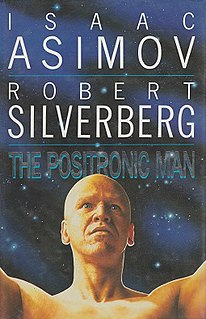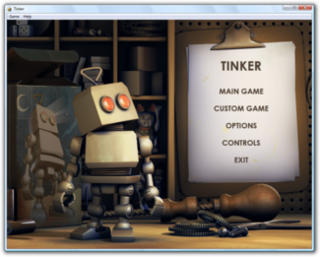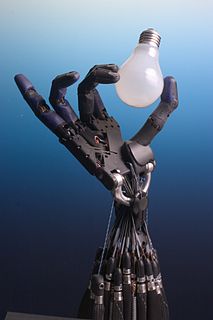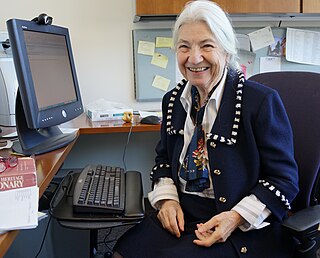Notes
- ↑ "Active Robots - Fairchild QRB1134 IR Photoreflector - UK". www.active-robots.com. Archived from the original on 2005-11-24.
A Photoreflector is a light emitting diode and a phototransistor housed in a compact package that can be used for detection of proximity and colour of objects.
They are a popular component in line following robots and other robotics. [1]

A robot is a machine—especially one programmable by a computer—capable of carrying out a complex series of actions automatically. A robot can be guided by an external control device, or the control may be embedded within. Robots may be constructed to evoke human form, but most robots are task-performing machines, designed with an emphasis on stark functionality, rather than expressive aesthetics.

The Three Laws of Robotics are a set of rules devised by science fiction author Isaac Asimov. The rules were introduced in his 1942 short story "Runaround", although they had been foreshadowed in some earlier stories. The Three Laws, quoted from the "Handbook of Robotics, 56th Edition, 2058 A.D.", are:

The Positronic Man is a 1992 novel by American writers Isaac Asimov and Robert Silverberg, based on Asimov's 1976 novelette "The Bicentennial Man".

I, Robot is a 2004 American science fiction action film directed by Alex Proyas. The screenplay by Jeff Vintar and Akiva Goldsman is from a screen story by Vintar, based on his original screenplay Hardwired, and named after Isaac Asimov's 1950 short-story collection. The film stars Will Smith, Bridget Moynahan, Bruce Greenwood, James Cromwell, Chi McBride, and Alan Tudyk. In 2035, highly intelligent robots fill public service positions throughout the dystopian world, operating under three rules to keep humans safe. Detective Del Spooner (Smith) investigates the alleged suicide of U.S. Robotics founder Alfred Lanning (Cromwell) and believes that a human-like robot called Sonny (Tudyk) murdered him.

Simultaneous localization and mapping (SLAM) is the computational problem of constructing or updating a map of an unknown environment while simultaneously keeping track of an agent's location within it. While this initially appears to be a chicken-and-egg problem there are several algorithms known for solving it, at least approximately, in tractable time for certain environments. Popular approximate solution methods include the particle filter, extended Kalman filter, covariance intersection, and GraphSLAM. SLAM algorithms are based on concepts in computational geometry and computer vision, and are used in robot navigation, robotic mapping and odometry for virtual reality or augmented reality.

A Cartesian coordinate robot is an industrial robot whose three principal axes of control are linear and are at right angles to each other. The three sliding joints correspond to moving the wrist up-down, in-out, back-forth. Among other advantages, this mechanical arrangement simplifies the Robot control arm solution. It has high reliability and precision when operating in three-dimensional space. As a robot coordinate system, it is also effective for horizontal travel and for stacking bins.
Service robots assist human beings, typically by performing a job that is dirty, dull, distant, dangerous or repetitive. They typically are autonomous and/or operated by a built-in control system, with manual override options. The term "service robot" does not have a strict technical definition. The International Organization for Standardization defines a “service robot” as a robot “that performs useful tasks for humans or equipment excluding industrial automation applications”.
The Laws of Robotics are a set of laws, rules, or principles, which are intended as a fundamental framework to underpin the behavior of robots designed to have a degree of autonomy. Robots of this degree of complexity do not yet exist, but they have been widely anticipated in science fiction, films and are a topic of active research and development in the fields of robotics and artificial intelligence.
Developmental robotics (DevRob), sometimes called epigenetic robotics, is a scientific field which aims at studying the developmental mechanisms, architectures and constraints that allow lifelong and open-ended learning of new skills and new knowledge in embodied machines. As in human children, learning is expected to be cumulative and of progressively increasing complexity, and to result from self-exploration of the world in combination with social interaction. The typical methodological approach consists in starting from theories of human and animal development elaborated in fields such as developmental psychology, neuroscience, developmental and evolutionary biology, and linguistics, then to formalize and implement them in robots, sometimes exploring extensions or variants of them. The experimentation of those models in robots allows researchers to confront them with reality, and as a consequence, developmental robotics also provides feedback and novel hypotheses on theories of human and animal development.

Laser guidance directs a robotics system to a target position by means of a laser beam. The laser guidance of a robot is accomplished by projecting a laser light, image processing and communication to improve the accuracy of guidance. The key idea is to show goal positions to the robot by laser light projection instead of communicating them numerically. This intuitive interface simplifies directing the robot while the visual feedback improves the positioning accuracy and allows for implicit localization. The guidance system may serve also as a mediator for cooperative multiple robots. Examples of proof-of-concept experiments of directing a robot by a laser pointer are shown on video. Laser guidance spans areas of robotics, computer vision, user interface, video games, communication and smart home technologies.
Mecha anime and manga, known in Japan as robot anime and robot manga, are anime and manga that feature robots (mecha) in battle. The genre is broken down into two subcategories; "super robot", featuring super-sized, implausible robots, and "real robot", where robots are governed by realistic physics and technological limitations.
Neurorobotics is the combined study of neuroscience, robotics, and artificial intelligence. It is the science and technology of embodied autonomous neural systems. Neural systems include brain-inspired algorithms, computational models of biological neural networks and actual biological systems. Such neural systems can be embodied in machines with mechanic or any other forms of physical actuation. This includes robots, prosthetic or wearable systems but also, at smaller scale, micro-machines and, at the larger scales, furniture and infrastructures.

Nao is an autonomous, programmable humanoid robot developed by Aldebaran Robotics, a French robotics company headquartered in Paris, which was acquired by SoftBank Group in 2015 and rebranded as SoftBank Robotics. The robot's development began with the launch of Project Nao in 2004. On 15 August 2007, Nao replaced Sony's robot dog Aibo as the robot used in the RoboCup Standard Platform League (SPL), an international robot soccer competition. The Nao was used in RoboCup 2008 and 2009, and the NaoV3R was chosen as the platform for the SPL at RoboCup 2010.

Mahendra Bhandari is a noted Indian surgeon who has made substantial contributions to the specialty of urology, medical training, hospital administration, robotic surgery and medical ethics. For his efforts, he was awarded the Padma Shri by the government of India in 2000. Bhandari is currently Senior Bio-scientist and Director of Robotic Surgery Research & Education at the Vattikuti Urology Institute (VUI) in Detroit, MI. He was the Symposium coordinator of the International Robotic Urology Symposium. He also has been the CEO of the Vattikuti Foundation since 2010.

Tinker, also known as Microsoft Tinker, is a puzzle video game developed by Fuel Industries in which the player controls a robot through various mazes and obstacle courses. It was originally released on September 23, 2008 as part of Windows Ultimate Extras, and contained 60 levels including a 20-level tutorial. A free map editor was also released, however it is not compatible with the Games for Windows – Live version of Tinker. It is only compatible with the Windows Ultimate Extras version.

Robotics is an interdisciplinary branch of computer science and engineering. Robotics involves design, construction, operation, and use of robots. The goal of robotics is to design machines that can help and assist humans. Robotics integrates fields of mechanical engineering, electrical engineering, information engineering, mechatronics, electronics, bioengineering, computer engineering, control engineering, software engineering, mathematics, etc.

Ruzena Bajcsy is an American engineer and computer scientist who specializes in robotics. She is Professor of Electrical Engineering and Computer Science at the University of California, Berkeley, where she is also Director Emerita of CITRIS.

A powered exoskeleton is a wearable mobile machine that is powered by a system of electric motors, pneumatics, levers, hydraulics, or a combination of technologies that allow for limb movement with increased strength and endurance. Its design aims to provide back support, sense the user's motion, and send a signal to motors which manage the gears. The exoskeleton supports the shoulder, waist and thigh, and assists movement for lifting and holding heavy items, while lowering back stress.

FIRST Power Up, stylised as FIRST POWER UP, is the FIRST Robotics Competition game for the 2018 season. It involves two alliances of three teams each, with each team controlling a robot and performing specific tasks on a field to score points. The game has a retro 8-bit theme and teams are required to place milk crates, or "power cubes", on large balancing scales to tip the scale and gain ownership. Alliances can also trade power cubes for power ups, giving them a temporary advantage in a match. At the end of the match, robots can climb the tower attached to the centre balancing scale using a rung attached to the tower, giving them additional points.